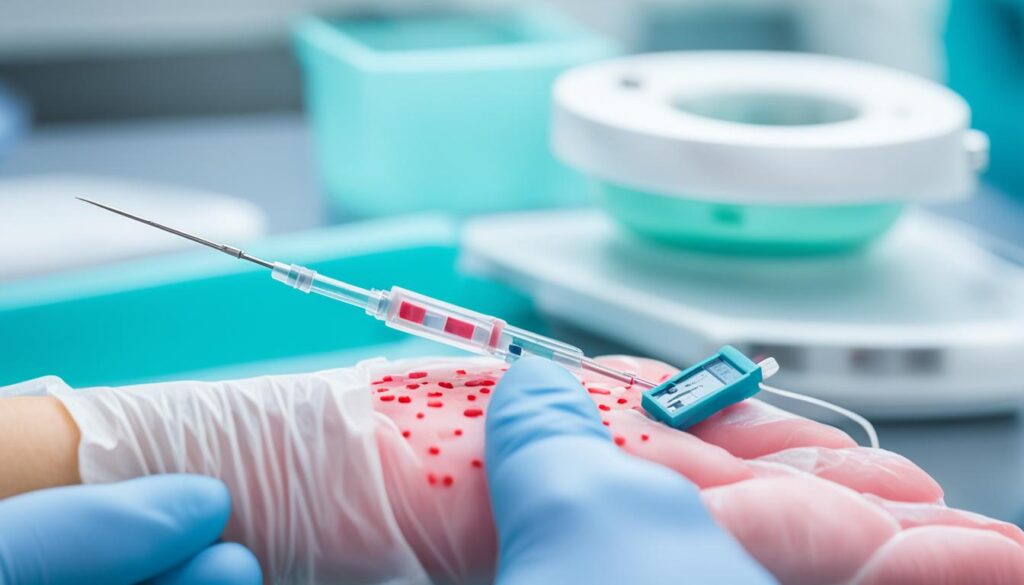Did you know that prostate cancer is the second most common cancer among men worldwide?
Prostate cancer is a serious condition that affects millions of men, and early detection is crucial for successful treatment and improved outcomes. By recognizing the symptoms and seeking medical attention promptly, men can increase their chances of a positive prognosis and effective management of the disease.
In this article, we will explore the importance of early detection and how to diagnose prostate cancer, as well as understanding the disease itself. We will discuss the prevalence of prostate cancer worldwide, the risk factors associated with it, and the common symptoms that should not be ignored. Additionally, we will delve into the screening methods, the stages of prostate cancer, diagnostic procedures, prevention strategies, and various treatment options available.
Our goal is to provide you with the knowledge and resources needed to make informed decisions about your prostate health and empower you to take proactive steps in maintaining your well-being.
Key Takeaways:
- Prostate cancer is the second most common cancer among men worldwide.
- Early detection is crucial for successful treatment and improved outcomes.
- Recognizing symptoms and seeking medical attention promptly is essential.
- Screening tests can help detect prostate cancer before symptoms appear.
- Understanding the stages, diagnostic procedures and treatment options is vital for informed decision making.
The Importance of Early Detection and Diagnosis of Prostate Cancer
Early detection and diagnosis play a vital role in the successful management of prostate cancer. By identifying the disease in its early stages, individuals have a better chance of receiving timely treatment and experiencing improved outcomes. The benefits of early intervention are numerous, ranging from higher survival rates to a wider range of treatment options.
Early detection allows healthcare professionals to take proactive measures in managing potential complications and side effects associated with prostate cancer. By catching the disease early, it becomes possible to explore less invasive treatment options and minimize the impact on a patient’s quality of life.
Recognizing the importance of early detection and diagnosis, individuals are encouraged to remain vigilant and proactive in monitoring their prostate health. Regular check-ups and screenings can help detect any abnormalities or signs of prostate cancer, even before symptoms manifest. This provides a significant advantage in terms of treatment and overall prognosis.
Take a moment to consider the impact of early detection and diagnosis in the illustration below:
| Benefits of Early Detection and Diagnosis of Prostate Cancer | Late-Stage Diagnosis | Early Detection and Diagnosis |
|---|---|---|
| Higher survival rates | Lower chances of survival | Increased chances of survival |
| Limited treatment options | Advanced disease progression | A wider range of treatment options |
| Higher risk of complications | Advanced side effects | Reduced risk of complications |
| Diminished quality of life | Physical and emotional distress | Improved quality of life |
As depicted in the table above, early detection and diagnosis of prostate cancer can substantially impact a patient’s journey. Through proactive measures, individuals can take control of their health and embrace the benefits that early intervention brings.
Understanding Prostate Cancer
Did you know that prostate cancer is the second most common cancer among men worldwide?
Prostate cancer is a significant health concern that affects millions of men, highlighting the importance of understanding its nature and early detection. By gaining a comprehensive understanding of prostate cancer, we can take proactive steps towards prevention, early diagnosis, and effective treatment.
Key Takeaways:
- Prostate cancer is the second most common cancer in men globally.
- Understanding the nature and risk factors of prostate cancer is crucial for early detection and successful treatment.
- Preventive measures such as quitting masturbation, reducing excessive sexual activity, following the Brahmacharya lifestyle, and practising positive affirmation can potentially reduce the risk of prostate cancer.
- Incorporating a healthy diet and regular exercise can also contribute to prostate health.
- Early detection through screening methods like the PSA test and the DRE is essential for timely intervention and improved outcomes.
Prostate Cancer Prevalence Worldwide
Prostate cancer is a significant global health issue affecting men around the world. The prevalence of prostate cancer varies widely based on geographic location and population demographics. Understanding the global prevalence of this disease is crucial for raising awareness, promoting early detection, and developing effective intervention strategies.
An image illustrating the worldwide prevalence of prostate cancer can provide insights into its distribution and impact. Please find below the relevant visualization:
This image showcases the global distribution of prostate cancer, highlighting the areas with higher incidence rates. Examining the prevalence of prostate cancer allows us to identify regions with a higher burden of the disease and allocate resources accordingly for prevention, early detection, and treatment strategies.
According to the World Health Organization, prostate cancer is the second most common cancer in men worldwide, with an estimated 1.4 million new cases reported in 2020 alone. The incidence rates vary significantly across continents and countries, influenced by factors such as age, genetics, lifestyle, and access to healthcare.
North America and Europe have reported higher incidence rates of prostate cancer, particularly in countries such as the United States and Sweden. African countries, including Nigeria and South Africa, also have a considerable burden of the disease.
Early detection plays a vital role in combating prostate cancer. By understanding the global prevalence and distribution of the disease, healthcare organizations and policymakers can implement targeted screening programs, raise awareness, and improve access to quality healthcare services.
Risk Factors Associated with Prostate Cancer
Prostate cancer is influenced by various risk factors that can increase the likelihood of its development. Understanding these risk factors can help individuals take proactive steps towards prevention and early detection. The following are some key risk factors associated with prostate cancer:
- Age: The risk of prostate cancer increases with age, particularly in men over the age of 50. Regular screening is recommended for men in this age group to detect any potential signs of the disease.
- Family history: Having a close relative, such as a father or brother, with prostate cancer can significantly increase an individual’s risk. Individuals with a family history of the disease need to be vigilant and discuss screening options with their healthcare providers.
- Ethnicity: Certain ethnic groups, such as African Americans, have a higher incidence of prostate cancer. Individuals from these populations need to be aware of their increased risk and prioritize regular screenings.
- Lifestyle choices: Certain lifestyle factors can contribute to the development of prostate cancer. These include smoking, obesity, and a sedentary lifestyle. Maintaining a healthy lifestyle by avoiding tobacco use, maintaining a healthy weight, and engaging in regular physical activity can help reduce the risk of prostate cancer.

By addressing these risk factors and adopting a proactive approach to prostate cancer prevention, individuals can significantly reduce their chances of developing the disease. It is important to consult with healthcare professionals for personalized guidance on risk assessment, early detection, and lifestyle modifications.
Recognizing Symptoms
Did you know that prostate cancer is the second most common cancer among men worldwide? It is estimated that over 1.4 million new cases of prostate cancer are diagnosed each year, making it a significant global health concern.
When it comes to prostate cancer, early detection is key. Recognizing the symptoms and seeking timely medical attention can make a crucial difference in the successful treatment and outcomes of this disease. By being proactive and attentive to your body, you can take charge of your prostate health and potentially save lives.
In this section, we will explore the common symptoms of prostate cancer that you should be aware of. It’s essential to understand these signs to ensure early detection and timely intervention for the best possible outcome.
Key Takeaways:
- Prostate cancer is the second most common cancer among men worldwide.
- Early detection is crucial for successful treatment and outcomes.
- Understanding the symptoms of prostate cancer is essential.
- Recognizing symptoms allows for timely medical intervention.
- By being proactive, you can take charge of your prostate health.
Common Symptoms of Prostate Cancer
Prostate cancer can present with various symptoms that may indicate the presence of the disease. It is important to be aware of these symptoms and seek medical attention if they occur. The common symptoms of prostate cancer include:
- Urinary changes: Men with prostate cancer may experience frequent urination, a weak urine flow, difficulty starting or stopping urination, and blood in the urine.
- Pain or discomfort: Prostate cancer can cause pain or discomfort in the pelvic area, lower back, or bones.
- Erectile dysfunction: Sometimes, prostate cancer can lead to difficulties with obtaining or maintaining an erection.
If you experience any of these symptoms, it is important to consult a healthcare professional for a proper evaluation. Keep in mind that these symptoms can also be caused by other conditions, but it is always best to get them checked out to rule out any potential underlying issues.
The Importance of Not Ignoring Symptoms
It is crucial not to ignore or dismiss potential symptoms of prostate cancer. Early detection and treatment offer the best chances of successful outcomes. If you experience any symptoms or have concerns about your prostate health, it is important to seek medical attention promptly. Ignoring symptoms can lead to delayed diagnosis and potentially worsen the prognosis.
Prostate cancer is a common condition that affects many men worldwide. Recognizing the early signs can help in detecting and diagnosing the disease at an early stage when treatment options are more effective. Some common symptoms of prostate cancer include urinary changes, pain or discomfort in the pelvic area, lower back, or bones, and erectile dysfunction.
By not ignoring these symptoms and seeking medical advice, you can take a proactive approach to your health. Early detection allows for timely intervention, which can significantly improve outcomes and increase the chances of successful treatment. Regular check-ups, screenings, and staying informed about the signs and symptoms of prostate cancer are important steps in safeguarding your prostate health.
It is also worth noting that certain lifestyle choices can contribute to the development of prostate cancer. Adopting a healthy diet, engaging in regular physical activity, and avoiding smoking and excessive alcohol consumption can help reduce the risk factors associated with prostate cancer.
Screening and Early Detection
Did you know that prostate cancer is the second most common cancer among men worldwide? According to the American Cancer Society, it is estimated that there will be over 248,500 new cases of prostate cancer diagnosed in the United States alone this year. With such staggering numbers, it is crucial to understand the importance of early detection and screening to combat this disease effectively.

Key Takeaways:
- Screening and early detection play a vital role in diagnosing prostate cancer at its earliest stage.
- Regular screening tests, such as the Prostate-Specific Antigen (PSA) test and Digital Rectal Examination (DRE), can help in identifying potential abnormalities.
- Being aware of the risk factors and recognizing the symptoms can prompt early medical attention.
- Prevention strategies like maintaining a healthy diet and active lifestyle can decrease the risk of developing prostate cancer.
- Seeking medical advice and treatment options as soon as possible offers the best chances of successful outcomes.
Screening Methods for Prostate Cancer
When it comes to detecting prostate cancer, various screening methods are utilized. These methods play a crucial role in identifying potential abnormalities and irregularities in the prostate gland, allowing for early intervention and improved treatment outcomes.
One of the commonly used screening tests is the Prostate-Specific Antigen (PSA) Test. This test measures the levels of a protein produced by the prostate gland, known as prostate-specific antigen. Elevated PSA levels can indicate the presence of prostate cancer or other prostate conditions. However, it’s important to note that the PSA test has limitations and can yield false-positive or false-negative results.
To complement the PSA test, healthcare professionals also perform a Digital Rectal Examination (DRE). During this procedure, a gloved finger is inserted into the rectum to feel the prostate gland for any abnormalities or irregularities. The DRE can provide valuable information about the size, texture, and overall condition of the prostate gland, assisting in the detection of potential issues.
While these screening methods are valuable tools in the early detection of prostate cancer, it’s important to consult with healthcare professionals to understand the limitations and recommendations associated with each method. Regular screenings and proactive measures help in the timely diagnosis and intervention, ensuring better outcomes for individuals at risk of prostate cancer.
Controversies Around Routine Screening
In the field of prostate cancer screening, there are ongoing debates and controversies surrounding the implementation of routine screening programs. This section aims to explore the potential benefits and drawbacks associated with widespread screening for prostate cancer, as well as the conflicting guidelines and recommendations provided by various medical organizations.
One of the main controversies surrounding routine screening for prostate cancer is overdiagnosis and overtreatment. While screening can help detect prostate cancer at an early stage, it can also identify slow-growing tumours that may never cause symptoms or pose a threat to the patient’s life. This leads to unnecessary treatments such as surgery, radiation therapy, or hormone therapy, which can potentially result in significant side effects and negatively impact the patient’s quality of life.
Another concern is the effectiveness of screening tests, specifically the Prostate-Specific Antigen (PSA) test. The PSA test has been widely used for prostate cancer screening, but it has limitations in terms of specificity and accuracy. Elevated PSA levels can be attributed to various factors other than prostate cancer, leading to false positives and unnecessary follow-up procedures.
Conflicting guidelines from medical organizations further contribute to the controversies surrounding routine screening for prostate cancer. For example, the United States Preventive Services Task Force (USPSTF) previously advised against routine PSA screening for all men, but later revised their recommendation to recommend shared decision-making between patients and healthcare providers.
On the other hand, organizations such as the American Cancer Society and the American Urological Association provide different guidelines, advocating for discussions about screening starting at age 50 (or 45 for high-risk individuals).
Individuals need to understand the controversies and consider the risks and benefits before making decisions about prostate cancer screening. Consulting with healthcare professionals and engaging in informed discussions can help guide personalized screening approaches based on individual risk factors, preferences, and values.

Stages of Prostate Cancer
Did you know that prostate cancer progresses through different stages, each with its implications for treatment and prognosis? This fact highlights the importance of understanding the stages of prostate cancer to guide medical decisions and ensure appropriate care.
Prostate cancer is a complex disease that can start in the prostate gland and, if left untreated, potentially spread to other parts of the body. By identifying the stage of the cancer, healthcare professionals can determine the best approach to treatment and offer personalized care.
Within the staging system, prostate cancer is typically categorized into four stages:
Key Takeaways:
- Prostate cancer progresses through different stages, indicating the extent and severity of the disease.
- Stage I: The cancer is confined to the prostate gland and has not spread beyond it.
- Stage II: The cancer has spread slightly within the prostate but remains localized.
- Stage III: The cancer has spread beyond the prostate to nearby tissues or organs.
- Stage IV: The cancer has metastasized to distant sites, such as bones, lymph nodes, or other organs.
- The stage of prostate cancer helps determine appropriate treatment options and prognosis.
Understanding the stages of prostate cancer empowers individuals and their healthcare providers to make informed decisions about treatment and management. By receiving an accurate stage diagnosis, patients can receive the most appropriate interventions, improving outcomes and enhancing their quality of life.
Diagnostic Procedures for Prostate Cancer
In diagnosing prostate cancer, various diagnostic tools and procedures are employed to confirm the presence of the disease. These procedures provide essential information for determining the appropriate treatment plan. The diagnostic procedures commonly used for prostate cancer include:
- Biopsy: A biopsy involves the extraction of a tissue sample from the prostate gland for analysis. This procedure is performed to determine if cancer cells are present and to assess the aggressiveness of the disease. Biopsies are considered the gold standard in diagnosing prostate cancer and provide an accurate assessment of its progression and stage.
- MRI Scans: Magnetic Resonance Imaging (MRI) scans are highly effective in detecting and locating tumours within the prostate gland and the surrounding areas. This non-invasive imaging technique provides detailed images that healthcare professionals can use to evaluate the extent and location of the cancer.
- Bone Scans: Bone scans are used to identify any signs of metastasis or the spread of prostate cancer to the bones. This important procedure helps determine the stage of the disease and guides treatment decisions.
- Ultrasound: Ultrasound imaging is commonly used to guide the placement of needles during a biopsy procedure. It helps visualize the prostate gland and aids in accurate tissue sampling for analysis.
- Genomic Testing: Genomic testing involves analyzing the genetic composition of the tumour cells to gain insights into the specific treatment options and prognosis. This personalized approach allows for tailored treatment plans and improved patient outcomes.
These diagnostic procedures, together with thorough clinical evaluations, play a critical role in accurately diagnosing and staging prostate cancer. They enable healthcare professionals to provide patients with the most appropriate and effective treatment strategies.

Prevention Strategies
Did you know that prostate cancer is the second most common cancer among men worldwide?
Prostate cancer affects millions of men, and its impact on individuals and their families cannot be overstated. While there is no guaranteed way to prevent prostate cancer, there are several strategies you can adopt to reduce your risk and promote overall prostate health.
Key Takeaways:
- Quitting masturbation and excessive sexual activity can potentially reduce the risk of prostate cancer.
- Following the Brahmacharya lifestyle, which emphasizes sexual abstinence and moderation, may have a positive impact on prostate health.
- Practising positive affirmation and maintaining a positive mindset has been linked to overall well-being and potentially reducing the risk of prostate cancer.
- Having a vegan diet that is rich in fruits, vegetables, and antioxidants may contribute to prostate health.
- Practising ManthanHub Brain Rewire, a technique that focuses on rewiring the brain’s neural pathways, can help improve mental health and potentially reduce stress levels.
By incorporating these unexpected prevention strategies into your lifestyle, you can take proactive steps towards reducing your risk of prostate cancer and maintaining your overall well-being.
Treatment Options
Did you know that prostate cancer is the second most common cancer in men worldwide?
Prostate cancer is a significant health concern that requires prompt diagnosis and appropriate treatment. With advancements in medical research and technology, there are several treatment options available for individuals diagnosed with prostate cancer. Each option is tailored to the specific needs and characteristics of the patient, aiming to achieve the best possible outcomes and improve quality of life.
Key Takeaways:
- Prostate cancer is the second most common cancer in men worldwide.
- Treatment options for prostate cancer vary depending on individual circumstances.
- Active surveillance is a non-invasive approach for low-risk prostate cancer, with close monitoring to ensure timely intervention if required.
- Surgery, such as prostatectomy, may be recommended to remove the prostate gland and any cancerous tissue.
- Radiation therapy, either external beam radiation or brachytherapy, aims to destroy cancer cells and prevent further growth.
- Hormone therapy can be used to suppress the production of testosterone, which fuels the growth of prostate cancer cells.
- Chemotherapy and immunotherapy may be considered for advanced cases where the cancer has spread beyond the prostate.
Guidelines and Recommendations
Did you know that following certain guidelines and recommendations can significantly impact the prevention and management of prostate cancer? In this section, we will explore the expert advice provided by reputable medical organizations regarding prostate cancer. These guidelines are designed to help individuals make informed decisions about their prostate health and ensure optimal outcomes. Let’s dive in!
Key Takeaways:
- Reputable medical organizations offer valuable guidelines and recommendations for prostate cancer prevention and management.
- Following these guidelines can help individuals make informed decisions about their prostate health.
- Implementing preventive strategies such as quitting masturbation, excessive sexual activity, and following a Brahmacharya lifestyle may reduce the risk of prostate cancer.
- Adopting a vegan diet, practising positive affirmations, and reducing stress levels can also contribute to prostate cancer prevention.
- Regular consultation with healthcare professionals and adherence to screening recommendations is crucial for early detection and appropriate management of prostate cancer.
Conclusion
In conclusion, early detection and diagnosis of prostate cancer play a critical role in ensuring successful treatment and improved outcomes. Individuals need to be proactive in recognizing symptoms and seeking medical attention for proper diagnosis. By being aware of the risk factors associated with prostate cancer, such as age, family history, ethnicity, and lifestyle choices, individuals can take necessary steps to reduce their risk.
While routine screening for prostate cancer remains a topic of debate, it is crucial not to ignore or dismiss potential symptoms. Recognizing symptoms such as urinary changes, pain or discomfort, and erectile dysfunction can prompt early medical assessment and intervention. Remember that early detection offers the best chances of successful treatment and management of the disease.
Prevention strategies, including following a healthy diet rich in fruits and vegetables, engaging in regular physical activity, quitting smoking and excessive alcohol consumption, practising positive affirmation, and adopting a Brahmacharya lifestyle, can contribute to reducing the risk of prostate cancer. Additionally, managing stress levels and seeking support for mental health through practices like ManthanHub Brain Rewire can promote overall well-being.
Ultimately, we encourage all individuals to prioritize their prostate health and overall well-being by staying informed, seeking medical advice when needed, and taking active steps towards prevention. By promoting awareness, early detection, and a proactive approach, we can work together to reduce the impact of prostate cancer and improve the lives of those affected.
FAQ
How to diagnose prostate cancer?
Prostate cancer diagnosis typically involves a combination of screening tests and diagnostic procedures. Screening tests, such as the Prostate-Specific Antigen (PSA) test and Digital Rectal Exam (DRE), can determine the need for further evaluation. Diagnostic procedures, such as biopsies, MRI scans, bone scans, ultrasound, and genomic testing, are used to confirm the presence of prostate cancer and assess its stage.
What are the 5 warning signs of prostate cancer?
The 5 warning signs of prostate cancer include frequent urination, weak urine flow, difficulty starting or stopping urination, blood in the urine, and pain or discomfort in the pelvic area, lower back, or bones.
What are the symptoms of stage 1 prostate cancer?
Stage 1 prostate cancer often doesn’t cause noticeable symptoms. However, some men may experience urinary changes, such as an increased need to urinate or difficulties with urination. It’s important to be aware of any changes in urinary habits and seek medical attention if concerned.
What are the signs of a bad prostate?
Signs of a potentially problematic prostate include urinary symptoms (such as increased frequency, weak urine flow, difficulty starting or stopping urination), pain or discomfort in the pelvic area, lower back, or bones, blood in the urine, and erectile dysfunction.
How long can I have prostate cancer without knowing?
Prostate cancer can develop and progress slowly, often without causing noticeable symptoms. As a result, individuals can have prostate cancer for several years without knowing. Early detection through regular screening and awareness of potential symptoms is crucial for timely diagnosis and treatment.
How do they check for prostate cancer?
Prostate cancer is typically checked through a combination of screening tests and diagnostic procedures. The Prostate-Specific Antigen (PSA) test measures the levels of a specific protein in the blood, while a Digital Rectal Exam (DRE) allows a healthcare professional to physically examine the prostate gland. Biopsies, imaging scans (such as MRI and ultrasound), and genomic testing may also be used to confirm a prostate cancer diagnosis.
What is prostate cancer?
Prostate cancer is a form of cancer that develops in the prostate gland, which is part of the male reproductive system. The prostate gland is responsible for producing seminal fluid, which nourishes and transports sperm. Prostate cancer occurs when the cells in the prostate gland undergo abnormal growth and begin to form tumours.
What are the treatment options for prostate cancer?
The treatment options for prostate cancer depend on various factors, such as the stage of the cancer and the individual’s overall health. Treatment options may include active surveillance, surgery (prostatectomy), radiation therapy (external beam or brachytherapy), hormone therapy, chemotherapy, and immunotherapy. The choice of treatment will be determined by the patient and their healthcare team.
What are the risk factors for prostate cancer?
Risk factors for prostate cancer include age (risk increases with age, especially in men over 50), family history (having a close relative with prostate cancer), ethnicity (African-Americans have a higher risk), and certain lifestyle choices (such as smoking, obesity, and a sedentary lifestyle).
What is the survival rate for prostate cancer?
The survival rate for prostate cancer varies depending on the stage at diagnosis and the individual’s overall health. In general, the five-year survival rate for localized prostate cancer is nearly 100%. However, if the cancer has spread to other parts of the body, the five-year survival rate drops to around 30%. Early detection and treatment contribute to higher survival rates.
Is prostate cancer preventable?
While it may not be possible to completely prevent prostate cancer, certain lifestyle choices can help reduce the risk. These include maintaining a healthy diet, engaging in regular physical activity, avoiding smoking and excessive alcohol consumption, limiting masturbation and excessive sexual activities, and following a Brahmacharya lifestyle. It’s important to discuss preventive measures with a healthcare professional.




